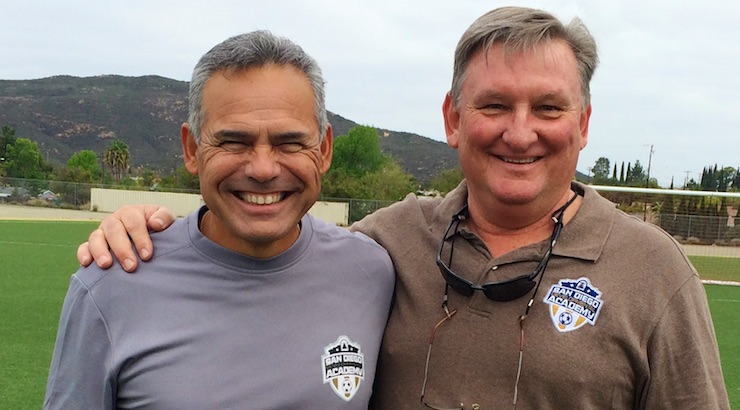After a Successful Inaugural Year, the San Diego Developmental Academy Prepares for an Encore
Barely a year ago, a group of five dedicated San Diego area Directors of Coaching put in motion the beginnings of a new league that would be dedicated to improving the development opportunities for local competitive youth soccer players. More than that, the five wanted a renewed focus on developing each player’s lifelong love for the game.
Within months, that idea had germinated to become the San Diego Developmental Academy (SDDA).
When Crusaders Soccer Club (CSC) Director of Coaching Rene Miramontes and Hotspurs USA Director of Coaching Paolo Landini began discussing the idea of a new league, the hope was to have a small group of teams participating. Eventually the plan was brought to Presidio Soccer League President Bob Turner for his input. He was immediately in favor of the idea, but he knew that the DOCs had to be the ones to carry it through to fruition.
“When Rene and Paolo brought the idea up my first thoughts were, ‘Okay, what do you guys have?’” Turner recalled during an interview between sessions of the successful SDDA-Army National Guard Soccer Clinic in March. “I had heard about it, but I stayed out of the planning because they had to own it. We’ve been concerned about players spending more time traveling to games than playing in the games, so I thought anything was worth a try.”
Miramontes and Landini then brought in Sami Nedjar from SD United, ChaCha Namdar from Scripps SC and Frank Zimmerman from Oceanside Breakers to help lay further groundwork for the new league. When the five brought the plan to the Presidio Board of Directors, Turner was there to advocate on their behalf. The Board was equally enthusiastic, and the SDDA became a reality.
In the beginning the Directors of the new league set their sights on some reasonable goals, with the idea of expanding as interest – and their experience running a league – grew.
What they didn’t expect was the overwhelming response to the SDDA.
Going into the first year, Turner explained, the hope was to have about 150 teams participating. Instead, nearly 600 teams applied and 400 were accepted into the league.
The SDDA also presented several successful college and player showcases, giving players the opportunity to shine on a larger stage.
“The first year was absolutely fabulous,” said Miramontes, who is also the Chairman of the SDDA.
“We over-achieved to such degree it’s not even funny. We were just hoping to get it started with a few teams, and the response and the acceptance in the soccer community have just been absolutely brilliant. The second season we’re only expecting it to get better and bigger. Hopefully we’ll achieve more milestones as we go on.”
“I think it was excellent, considering that we put the whole thing together in a matter of months,” said Namdar during a break in training at the National Guard clinic. “All of a sudden we were over 400 teams.”
“There are some things we learned from it, but overall, from a first-year standpoint, it went much better than I anticipated,” Turner admitted. “I expected a lot more headaches. For something that was basically put together a couple months before the season started, it went wonderfully. I think it’s only going to be better.”
For the second season, Turner explained that the SDDA has plans to bring in some higher-level coaches to work with the DOCs of the participating clubs, to help in the focus on bringing them to “Blue Ribbon” status. There will still be the college and player showcases, and 2014 may include some form of All-Star program to help players to get more exposure among college coaches.
“We’re always looking to improve, and I think people will see that in the second year,” said Namdar. “The level of competition is the most important thing for us, and we want to make sure the best players are playing at a high level. That will be our focus going forward.”
In addition to the focus on players, Turner hopes to see more participation from club DOCs in the second year. He understands that administration is not always their forte – they are, after all, coaches first – but having more DOCs at the showcases is important to the league’s success. It not only shows the commitment to the overall success of SDDA, but it gives them the opportunity to network with college coaches.
“I would like to see more participation from the other DOCs this year,” Turner said. “We had 37 clubs in the league last year, and maybe 10 to 15 of the Directors were good about being active and participating. We put on nine different weekends of showcases, and that was not nearly enough help. We need them out there like Rene and ChaCha are, mingling with college coaches.”
“Five DOCs shouldn’t have to be at all the events all day.”
The first SDDA season was a remarkable success. Parents, players and coaches were all excited about the showcases, and parents especially appreciated not having to make long road trips every weekend just for their children to play a single game. Many lessons have been learned, and the SDDA Board plans to use that knowledge to continue to improve.
“Players should understand that we are there for them,” Namdar said. “We want to create that desire and a level of competition that they want to be involved in, and we want them to believe in this system. We’re out there working hard to make sure that we are providing what they need for their future. Hang in there with us until we get all the little kinks worked out.”






